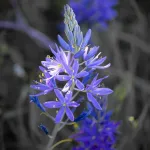(Press-News.org) An Oregon State University study found evidence that Indigenous groups in the Pacific Northwest were intentionally harvesting edible camas bulbs at optimal stages of the plant’s maturation as far back as 3,500 years ago.
The findings contribute to the growing body of research around Traditional Ecological Knowledge and practices, demonstrating the care and specificity with which Indigenous groups have been stewarding and cultivating natural resources for millennia.
Camas is an ecological and cultural keystone, meaning it is a species that many other organisms depend on and that features prominently within many cultural practices.
“If you think about salmon as being a charismatic species that people are very familiar with, camas is kind of the plant equivalent,” said Molly Carney, an assistant professor of anthropology in OSU’s College of Liberal Arts and lead author on the study. “It is one of those species that really holds up greater ecosystems, a fundamental species which everything is related to.”
An eye-catching blue flower that grows widely throughout the Pacific Northwest, camas is referred to in Indigenous calendars across the region, with the plant’s growth stages used as a sort of seasonal benchmark. It is often included in traditional First Food ceremonies, in which tribal communities mark the coming of spring with the first salmon run or the first edible roots after a long winter, Carney said.
Camas bulbs must be baked for two to three days to render them edible. Once soft, the bulbs taste a bit like sweet potato, Carney said. Traditional baking was done in underground ovens using heated rocks.
The archaeological record Carney examined included the remains of these large pit ovens. After cooking the bulbs, Indigenous peoples had many ways to process camas and were able to store it for many months at a time. (Even Lewis and Clark’s diaries mention eating camas they were given by Nez Perce tribal members.)
In the recent study, published in The Holocene, Carney looked at camas bulbs from the Willamette Valley in Oregon dating back 8,000 years to determine when in their life cycle they were harvested. Similar to how tree rings help to estimate how old a tree is, counting the interior leaf scales of a camas bulb lets you estimate its age. Camas grows to harvestable size in three to five years, depending on soil conditions.
Camas baking ovens from 4,400 years ago have been recorded at a Long Tom River archaeological site near Veneta, Ore., but for several thousand years, the bulbs appeared to have been harvested somewhat indiscriminately. Carney found that around 3,500 years ago, the bulbs started being harvested more selectively at the point when the plants were four or five years old and had reached sexual maturity.
This timing in the Late Holocene period lines up with broader climatic shifts in the region, the researchers noted, coming around the same time as low-magnitude fires became more commonplace in the landscape. Carney also studied lake-core evidence from the floor of Beaver Lake, collected by Central Washington University researcher Megan Walsh, that gives credence to the theory that controlled burns were used intentionally to create optimal conditions for camas and other plants starting 3,000 to 4,000 years ago.
Based on her research, Carney says it’s clear that Native communities at the time were not selectively harvesting for the biggest possible bulbs, but rather stewarding camas to be sustainable over time.
“They were trying to maintain the age structure of these camas populations within a pretty narrow window,” she said. “When I had the opportunity to harvest alongside tribal communities, as they harvest, they replant the smaller bulbs as they go. They’re really sowing for future harvest, and that’s what I think was happening here.”
The shift from haphazard harvesting to selective stewardship among tribal communities appears to have occurred at approximately the same time throughout the Pacific Northwest, Carney said. And for the practice to be successful, it would have required community-wide agreement and cooperation to leave immature camas bulbs in the ground until the optimal harvest point, as well as to conduct the type of cultural burning necessary to maintain healthy growing spaces, the researchers note.
“We have these records showing that people were taking active roles in creating landscapes that fit their needs, and that they’ve been doing so for 3,500 years at least, based on these two proxies of camas and fire,” Carney said. “That provides a powerful claim for restoring these practices.”
Co-author on the study was Thomas Connolly from the Museum of Natural and Cultural History at the University of Oregon. The project was approved by the Confederated Tribes of Grand Ronde Historic Preservation Office.
END
Legacy of Indigenous stewardship of camas dates back more than 3,500 years, OSU study finds
2024-05-22
ELSE PRESS RELEASES FROM THIS DATE:
Regular fish oil supplement use might boost first time heart disease and stroke risk
2024-05-22
Regular use of fish oil supplements might increase, rather than lessen, the risk of first time heart disease and stroke among those in good cardiovascular health, but may slow progression of existing poor cardiovascular health and lower the risk of death, suggest the results of a large long term study, published in the open access journal BMJ Medicine.
Fish oil is a rich source of omega 3 fatty acids, and as such, is recommended as a dietary preventive to ward off the development of cardiovascular disease. But the evidence on how much protection it affords is inconclusive, explain the researchers.
To strengthen the evidence base, they set out to estimate the associations ...
Some teen girls clocking up close to 6 smartphone hours/day, Finnish study finds
2024-05-22
Some teenage girls are clocking up close to 6 hours a day on their smartphones, with a significant proportion of them likely addicted to social media, finds research published online in the journal Archives of Disease in Childhood.
Social media addiction was associated with poorer health and wellbeing, the findings indicate.
Recent research has linked increasing levels of anxiety among teen girls with social media use, note the researchers. This may involve several factors, one of which is addiction, with estimated international prevalence ranging from 5% to 31%, they add.
Because both anxiety and social media use are more common among girls, the researchers wanted to: measure ...
Pedestrians may be twice as likely to be hit by electric/hybrid cars as petrol/diesel ones
2024-05-22
Pedestrians may be twice as likely to be hit by an electric or hybrid car as those powered by petrol or diesel, finds a study of 2013-17 casualty rates in Great Britain, and published online in the Journal of Epidemiology & Community Health.
The risk is greater in urban areas, and governments must take steps to mitigate this safety hazard as they proceed to phase out fossil fuelled vehicles to improve air quality and curb climate change, urge the researchers.
Road traffic injuries are the leading cause of death for children and young people, and 1 in 4 road traffic deaths are of pedestrians, they note.
Amid ...
Scientists create tailored drug for aggressive breast cancer
2024-05-22
Scientists have used breast cancer cells’ weakness against themselves by linking a tumour-selective antibody with a cell-killing drug to destroy hard-to-treat tumours.
The research, published today in Clinical Cancer Research by a team from King’s College London and funded by Breast Cancer Now, marks a new method in cancer treatment.
The discovery is particular to triple negative breast cancer, which makes up 15% of all diagnosed breast cancer. This type of breast cancer is typically aggressive, resistant to chemotherapy, has a lower survival rate and is more common in women under 40.
Usual treatment involves surgery, chemotherapy ...
Language change harms our ability to communicate and understand
2024-05-22
EMBARGO: WEDNESDAY 22 MAY, 00:01 BST (TUESDAY 21 MAY, 19:01 ET).
Changes to the definitions of conceptual words like ‘woke’ and ‘gaslighting’ are harming our ability to communicate and understand our experiences, a Leeds academic argues.
In a new paper published in The Philosophical Quarterly journal, an ethicist at the University of Leeds has coined a term for the harm caused when language change leaves us lost for words.
Words such as ‘woke’, ‘depression’, ...
Jamestown Colony residents ate dogs with Indigenous ancestry
2024-05-22
Dogs with Indigenous ancestry were eaten during a period of starvation at Jamestown, the first English settlement in North America in the 17th century, according to new research in American Antiquity, published by Cambridge University Press on behalf of the Society for American Archaeology.
This discovery changes historians’ understanding of how Indigenous communities negotiated their relationship with rising colonial powers during this period. It also suggests that early European colonists depended on local Indigenous communities for their very survival, especially during the initial settlement period.
Researchers analysed ancient mitochondrial DNA from archaeological dogs from Jamestown ...
Australian study proves ‘humans are planet’s most frightening predator’
2024-05-22
Australia lacks fearsome large carnivores like lions and wolves, and the relative lack of fear that marsupials like kangaroos and wallabies show to dogs (and other introduced carnivores) has been attributed to a lack of evolutionary experience with large mammalian predators. This, however, overlooks the 50,000-year-long presence in Australia of the world’s most fearsome predator – the human ‘super predator.’
A new study conducted by Western University biology professor Liana Zanette, in collaboration with Calum ...
New York Valves 2024 late-breaking clinical trials and science announced
2024-05-22
NEW YORK – May 21, 2024 – The Cardiovascular Research Foundation® (CRF®) has announced New York Valves: The Structural Heart Summit will feature 12 Late-Breaking Clinical Trials and Science presentations. New York Valves 2024, the expanded iteration of our renowned annual Transcatheter Valve Therapy (TVT®) conference, will take place June 5-7, 2024, at the Jacob K. Javits Convention Center, North in New York City.
For nearly two decades, CRF® has led the way in pioneering transcatheter therapies for structural heart ...
Few moderate or severe asthma patients prescribed recommended inhaler regimen
2024-05-22
EMBARGOED UNTIL: 2:15 p.m. PT, May 21, 2024
Session: C94 - Asthma Quality Improvement, Health Services Research, and Disparities
Utilization of Single Maintenance and Reliever Therapy (SMART) for Moderate and Severe Asthma
Date and Time: Tuesday, May 21, 2024, 2:15 p.m.
Location: San Diego Convention Center, Room 28A-B (Upper Level)
ATS 2024, San Diego – Only 14.5 percent of adult patients with moderate or severe asthma are prescribed the recommended SMART combination inhaler regimen and over 40 percent of academic pulmonary and allergy clinicians have not adopted this optimal therapy, according to research published ...
A new way to fight an aggressive cancer in dogs
2024-05-22
Hemangiosarcoma is a common and aggressive type of cancer in dogs that arises from blood vessel cells and spreads very quickly, throughout the body, frequently affecting the spleen, liver, heart and muscles, among other organs.
“Because this type of cancer comes from blood vessels, it is common for these tumors to suddenly cause massive bleeding into the abdomen or chest,” says Heather Gardner, D.V.M., Ph.D., DACVIM (Oncology), GBS20. “Often when a dog is diagnosed, it is an emergency due to the blood loss associated with tumor rupture. They can have other problems related to hemangiosarcoma, such as lethargy, weakness, and ...


